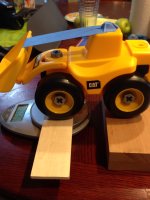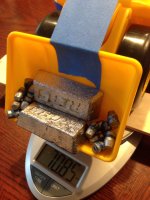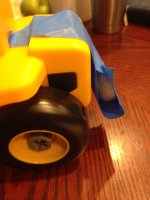AxleHub
Elite Member
I have to admit . . And have in my pists . . If an operator is willing to operate with only one axle in contact with the ground . . Then you can shift weight. But that is neither an acceprable ir safe operating condition by tractor definition. I believe that definition requires each axle and tire have ground contact. Would anyone disagree with that definition to operate the tractor ?
So at that point . . . Math is not a function because unless you add or remove air in tires . . Or alter the pitch/slope of the land . . You can't get "down" any lower than tires and wheels and axles being in ground contact. And all the leverage you use stops when you can't go down on one side and up on the other. Now you can alter the height the weight is carried at just as you can change the ground slope or air pressures in tires . . . But all ballast does is keep the 2 axles and 4 tires in ground contact and if 2 axles and 4 tires are in the exact same spot . . . More ballast on the rear increases the rear axle load but thats the ballast doing it. But I see no way for front axle load to be reduced by ballast.
As I opinioned before . . more ballast on one end of the tractor gives the operator a choice to add more weight on the front end but i see no way to lessen the weight that already exists on that front axle UNLESS you are willing to violate the tractor definition of 2 axles and 4 wheels in ground contact.
Now I'll be happy to read and listen to other viewpoints as long as the one standard is a tractor definition of all 4 wheels and 2 axles in ground contact.
Who knows . . uf this debate has often repeated in the past . . maybe I'll have to say I'm in error. Lol
So at that point . . . Math is not a function because unless you add or remove air in tires . . Or alter the pitch/slope of the land . . You can't get "down" any lower than tires and wheels and axles being in ground contact. And all the leverage you use stops when you can't go down on one side and up on the other. Now you can alter the height the weight is carried at just as you can change the ground slope or air pressures in tires . . . But all ballast does is keep the 2 axles and 4 tires in ground contact and if 2 axles and 4 tires are in the exact same spot . . . More ballast on the rear increases the rear axle load but thats the ballast doing it. But I see no way for front axle load to be reduced by ballast.
As I opinioned before . . more ballast on one end of the tractor gives the operator a choice to add more weight on the front end but i see no way to lessen the weight that already exists on that front axle UNLESS you are willing to violate the tractor definition of 2 axles and 4 wheels in ground contact.
Now I'll be happy to read and listen to other viewpoints as long as the one standard is a tractor definition of all 4 wheels and 2 axles in ground contact.
Who knows . . uf this debate has often repeated in the past . . maybe I'll have to say I'm in error. Lol



